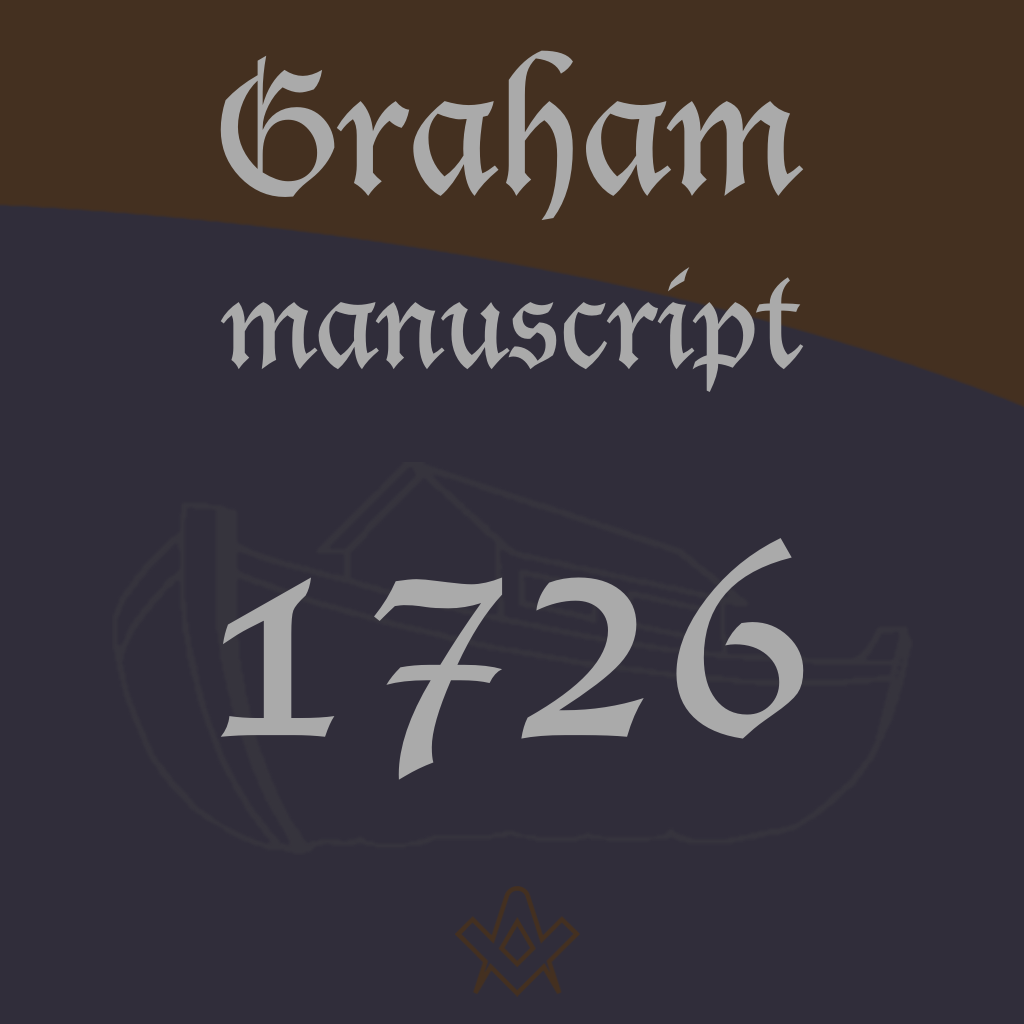The Graham Manuscript dating from 1726 is an early Masonic document that calls upon Noah and this three sons in respect to Masonry, an alternative allegory to the Hiram legend.
The document, now known as the ‘Graham Manuscript’, had been in the possession of the family of Rev H. I. Robinson of Londesborough Rectory in York. Rev Robinson first mentioned its existence when he was initiated in 1936. Prior to the Robinson family, the history and whereabouts of the manuscript remain unknown.
The date is stated as ‘october ye 24 1726‘ and the ‘author’ as Tho[mas] Graham.
Bro Graham had most likely transcribed the document from an earlier manuscript, as according to Masonic scholar John Acaster in his paper ‘The Noah legend and the Graham Manuscript A fresh appreciation of The Whole Institutions of Free Masonry Opened and its significance today‘ (AQC131), ‘he [Graham] makes mistakes, misquoting the Bible’.
Acaster goes on to demonstrate how dating of the original text from dialogue and references is made difficult as a ‘dialect of N. E. England is used in the text’ but ‘more clues can be adduced by way of its religious slant and phraseology…other features also point towards a likely date of composition as being c.1630-1670’.
Entitled The whole Institution of free Masonry opened and proved by the best of tradition and still some reference to scripture, the document begins with an examination of a Master Mason, in the form of the sort of question and answer catechism seen in earlier rituals, to establish his position.
He is questioned on his ‘entering’, ‘raising’, and also a very long answer regarding ‘the works of the Baballonians [Babylonians]’.
What follows is a version of the Third Degree legend involving Noah instead of Hiram Abiff; somewhat different to the degree now transmitted to Master Masons.
The text relates what modern Masons would recognise as the part of the legend of Hiram Abiff, which deals with the recovery of his body.
However, in this instance the body is that of Noah, disinterred by his three sons in the hope of learning some secret, and the Mason’s word is cryptically derived from his rotting body.
Hiram Abiff is mentioned, but only as Solomon’s master craftsman, inspired by Bezalel, who performed the same function for Moses.
So who came first, Noah or Hiram? In his paper ‘Hiramic Legend: Whence and Wherefore‘, W.Bro. Chakravarthy Sampath Madhavan makes the pertinent statement that ‘Anderson, in the book of Constitutions of 1723 calls Noah and his three sons “all Masons true”.
This perhaps was an admission that the legend of Noah was in use at that time and a hint that its inclusion in the ritual of the proposed Third Degree was being contemplated by him and Dr Desaguilers’.
He goes on further to explain why the legend of Noah and his three sons ‘amply illustrated the message of the Third Degree’ but was perhaps replaced with the Hiramic legend because the former lacked ‘betrayal, violent death, martyrdom, and revenge’.
Food for thought!
The Graham Manuscript is now in the possession of the Library of Freemasonry, London.
Transcription of the Manuscript
Example of the original layout:
ffirst observe that all our signes is taken from the square according to / every subject in handleing this is proved by the 9 vers of 6 chapter / of ffirst book of kings – The Sallutation is as ffollows – 1. ffrom whence came you – I came ffrom a right worshipfull Lodge of Masters and ffellows belonging to / God and holy saint John who doth greet all true and perfect brothers of our / holy secrets so do I you if I finde you to be one – 2. I greet you well brother craveing your name – answere J and the other is to say / his is B The examination is a follows – 3. How shall I know you are a ffree Mason – / By true word signes and tokens from my entering – / 4. How were you made a free mason – by a true and perfect Lodge – / 5. what is a perfect Lodge – the senter of a true heart – / 6. But how many masons is so called – and od number from 3 to 13 – / 7. why so much ado and still having od numbers – / still in refferance ffrom the blesed trinity to the comeing of christ with his 12 apostles / 8. what was the first step towards you entering – / a willing disire for to know the secrets of free masonry – / 9. why was it called free masonry – …
Below is an edited layout of the text as the original is not an easy read; as you can see from the example above, the original textual layout is practically one paragraph with no indentations, nor coherent or consistent punctuation; line breaks are merely indicated by a ‘/’.
The text that follows still contains the original spellings and vernacular (most of which is easily understood), however, we have removed the use of multiple ‘ff’, for ease of reading, and inserted notes as required.
The whole Institutions of Free-Masonry opened and proved by the best of Tradition and still some reference to Scripture.
First observe that all our signes is taken from the square according to every subject in handleing this is proved by the 9 vers of the 6 chapter of first book of kings.
The Sallutation is as follows:
Question. – From whence came you?
Answer. – I came from a right worshipfull Lodge of Masters and fellows (1) belonging to God and holy saint John who doth greet all perfect brothers of our holy secrets so do I you if I find you be one.
Q. – I greet you well Brother craveing your name?
Answere J and the other is to say his is B.
The examination as follows:
Q. – How shall I know you are a free Mason?
A. – By true words signes and tokens from my entering.
Q. – How were you made a free Mason?
A. – By a true and perfect Lodge.
Q. – What is a perfect Lodge?
A. – The senter of a true heart.
Q. – But how many masons is so called?
A. – Any od number from three to 13.
Q. – Why so much ado and still having od numbers?
A. – Still in referance from the blesed trinity to the comeing of christ with his 12 apostles.
Q. – What was the first step towards your entering?
A. – A willing disire for to know the secrets of free masonry.
Q. – Why is it called free masonry (2)?
A. – First because a free gift of God to the children of men secondly free from the intruption of infernall spirits thirdly a free union amonge the brothers of that holy secret to remain for ever.
Q. – How came you into the Lodge?
A. – Poor and penyless blind and Ignorant of our secrets.
Q. – Some reason for that?
A. – In regard our saviour became poor for our redemption so I became poor at that time for the knowledge of God contracted in the square.
Q. – What did you see in the Lodge when you did see?
A. – I saw truth the wolrd and Justice and brotherly Love.
Q. – Where?
A. – Before Me.
Q. – What was behind you?
A. – Perjury and hatred of Brotherhood for ever if I discover our Secrets without the consent of a Lodge Except that have obtained a trible [triple?] Voice by being entered passed and raised and Conformed by three severall Lodges and not so Except I take the party sworn to be true to our articles.
Q. – How stood your Lodge at your entering?
A. – East west and south.
Q. – Why not north also?
A. – In regard we dwell at the north part of the world we burie no dead at the north side of our churches so we cary a Vacancey at the north side of our Lodges.
Q. – Why east and west?
A. – Because churches stands eats and west and porches to the south.
Q. – Why doth churches stand east and west?
A. – In four references.
Q. – What are they?
A. – First our first parance was placed Eastward in edin – secondly the East winde dryed up the sea before the children of Israell so was the temple of the Lord to be builded – thirdly these who dwell near the Equenoxall the sun riseth and seteth west on them – fourthly the stare appeared in the East that advertised both the sheep heards and wise men that our saviour was come in the flesh.
Q. – Who Conducted you into the Lodge?
A. – The warden and the oldest fellow craft.
Q. – Why not the youngest fellow craft?
Q. – In regard our Saviour exorted the chiefe to Serve at the table that being an exortation to Hummility to be observed by us for ever.
Q. – What poster did you pass your oath in?
A. – I was nether siting standing goeing running rideing hinging nor flying naked nor cloathed shode nor bairfoot.
Q. – A reason for such poster?
A. – In regard one God one man makes a very christ so one naked object being half naked half cloathed half shode half bairfoot half kneeling half standing being half on all was one on the whole this sheweth a humble and obedient heart for to be o faithfull follower of that Just Jesus.
Q. – What were you sworn to?
A. – For to hale and conceal our secrets.
Q. What other tenours did your oath Cary?
A. – My second was to obey God and all true Squares made or sent from a brother my third was never to steall Least I should offend God and shame the square my fourth was never to commite adultery with a brothers wife nor tell him a willfull lie my fifth was to disire no unjust revange of a brother but Love and relieve him when its in my power it not horting my self too far.
Q. – I pass you have been in a Lodge yet I demand how many Lights belongs to a Lodge?
A. – I answer 12.
Q. – What are they?
A. – The first three jewells is father son holy ghost sun moon Master Mason square Rule plum Lyne Mell and cheisall.
Q. – Prove all thses proper?
A. – As for the blesed trinity they afurd reason as for the sun he renders Light day and night as for the moon she is a dark body of water and doth receive her Light from the sun ans is also queen of waters which is the best of Leavells as for the Master Mason he teaches the trade and ought to have a trible [triple?] voice in teaching of our secrets if he be a bright man because we do be Leive into a Supper oratory power for alltho the 70 had great power Yet the 11 had mor for they chused matthias in place of Judas as for square Rule plum lyne mell and cheisall they are six toolls that no mason can performe true work without the major part of them.
Q. – What referance can be prest on the 12 Lights?
A. – We draw referance from the 12 patriarches and also from the 12 oxen we reid of at the 7 chapter of first king that caryed up the molten sea of brass which was tipes of the 12 disciples was to be tought by christ.
Q. – I pass you entered yet I demand if you were raised?
A. – Yes I was.
Q. – Into what were you raised?
A. – I was raised into knowled of our primitive both by tradition and scripture.
Q. – What is your foundation words at the Laying of a builiding where you exspect that some infernall squandering spirit hath haunted and posable may shake your handy work?
A. – O come Let us and you shall have.
Q. – To whom do you speak?
A. – To the blesed trinity in prayer.
Q. – How do you administer these words?
A. – Kneeling bairhead face towards the east.
Q. – What mean you by the exspreshion thereof?
A. – We mean that we forsake self righteiouness and difers from these baballonians [Babylonians] who presumed to build to heaven but we pray the blesed trinity to Let us build truely and square and they shall have the praise to whom it is due.
Q. – When was these words made or what need was for them?
A. – I answere into the primitive before the ghospell spraid the world being incumbered with infernall squandering spirits except that men did build by faith and prayer their works were oft asulted.
Q. – But how came that the works of the Baballonians [Babylonians] stood before all this or yet the brightness of the gospell?
A. – I yet by your own question answere you because the presumption of the Baballonians [Babylonians] aforesaid had vexed the God head in so much the Langvage was Confounded for their sake so that no mankind for ever was to do the Like again without a devine Lisiance which could not be had wtout faith and prayer.
Q. – Tradition that [?]
A. – We have it by tradition and still some referance to scripture cause shem ham and Japheth for to go to their father noahs grave for to try if they could find anything about him for to Lead them to the vertuable secret which this famieous preacher had fot I hop all will allow that all things needful for the new world was in the ark with noah.
Now these three men had allready agreed that if they did not find the very thing it self that the first thing that they found was to be to them as a secret they not Douting but did most firmly be Leive that God was able and would also prove willing through their fatihtri prayer and obedience for to cause what they did find for to prove as vertuable to them as if they had received the secret at first from God himself at its head spring so came to the Grave finding nothing save the dead body all most consumed away takeing a greip at a finger it came away so from Joynt to Joynt so to the wrest so to the Elbow.
So they Reared up the dead body and suported it setting foot to foot knee to knee Breats to beast Cheeck to check and hand to back and cryed out help o father as if they had said o father of heaven help us now for our Earthly father cannot so Laid down the dead body again and not knowing what to do.
So one said here is yet marrow in this bone and the second said but a dry bone and the third said it stinketh so they agreed for to give it a name as is known to free masonry to this day so went to their undertakings and afterwards works stood: yet it is to be beleived and also understood thet the vertue did not proceed from what they found or how it was called but from faith and prayer so thus it Contenued the will pass for the deed.
While the reigne of king alboyne [Alban] then was born Bazalliell [Bezalel] who was so Called of God before conceived in the [womb] and this holy man knew by inspiration that the secret titles and primitive pallies of the God head was preservitiv and he builded on them in so much that no infernall squandering spirit durst presume to shake his handy work so his works be came so fameious while the two younger brothers of the foresaid king alboyin [Alban] disired for to be instructed by him his noble asiance by which he wrought to which he agreed conditionally they were not to discover it without a another to themselves to make a trible [triple?] voice so they entered oath and he tought them the heorick [theory]and the practick part of masonry and they did work.
Then was masons wages called up in that realme then was masons numbered with kings and princes yet near to the death of Bazalliell [Bezalel] he disired to be buried in the valey of Jehosephate and have cutte over him according to his diserveing which was performed by these two princes and this was cutte as follows.
Here Lys the flowr of masonry superiour of many other companion to a king and to two princes a brother Here Lys the heart all secrets could conceall Here lys the tongue that never did reveal.
Now after his death the inhabitance there about did think that the secrets of masonry had been totally Lost because they were no more heard of for none knew the secrets therof Save these two princes and they were so sworn at their entering not to discover it without another to make a trible [triple?] voice.
Yet it is to be beleived and allso under stood that such a holy secret could never be Lost while any good servant of God remained alive on the earth for every good servant of God had hath and allways will have a great part of that holy secret alltho they know it not themselves nor by what means to make use therof for it hapened with the world at that time as it did with the Sammaritan church about christ they were Seeking for what they did not want.
But their deep Ignorance could not disarne it so all this contenued dark and obscure while the four hundred and four Score of year after the children of Israell came out of the Land of Egypt in the fourth year of Sollomons reigne over Israell that sollomon begun to Build the house of the Lord which his father david should have builded but was not admited to performe it because his hands was gultie of blood wars being on every side.
So all refered while the days of Sollomon his son that he be gun to build the house of the Lord now I hope all men will give for granted that all things needfull for carying on of that holy errection was not holden from that wise king.
To this we must all allow Els we must charge God with unJustice which no fraill mortall dare presume to charge God with nether can his devine goodness be Guilty of now we read at the 13 vers of the 7 chapter of first book of kings that Sollomon sent and fet hiram out of tyre he being a widdows son of the tribe of naphtale and his father was a man of tyre a worker in brass filled with wisdom and Cunning to work all works in brass and he came to king sollomon and wrought all his work for him.
The Explanation of these verses is as follows:
The word Cunning renders ingenuity as for wisdom and understanding when they are both found in one person he can want nothing: so by this present scripture must be allowed that the widows Son whose name was hiram had a holy inspiration as well as the wise king sollomon or yet the holy Bazalliell [Bezalel].
Now it is holden forth by tradition that there was a tumult at this Errection which should hapened betwext the Laborours and masons about wages and for to call me all and to make all things easie the wise king should have had said be all of you contented for- you shall be payed all alike yet give a signe to the Masons not known to the Laborours and who could make that signe at the paying place was to be payed as masons the Laborours not knowing thereof was payed as foresaid.
This might have been yet if it was so we are to Judge very Mercyfull on the words of the wise king sollomon for it is to be understood and allso beleived that the wise king meant according to every mans disarveing yet the 7 vers of the 6 chapter of first book of kings reads me still Better where it is said the House when it was in Building was build of ston made ready before it was brought theither so that there was nether hammer nor ax nor any tooll of Iron heard in the house when it was in Building.
From whence may be gathered that all things was flitted afore hand yet not posable to be caryed on without a motion and when all things were sought from the horasin of the heavens to the plate form of the earth there could be nothing found more be Comeing more becomeing then then the square for to be their signe for to signifie what they would have each other to do.
So the work went on and prospered which could not well go amiss being they wrought for so good a Master and had the wisest man on earth for to be their overseer therefore in so parts by Merite yet Much mor by free grace Masonry obtained a name and a new command.
Their name doth signifie strength and their answere beauty and theire command Love for proofe hereof read the 7 and 6 of first book of kings where you will finde the wonderfull works of hiram at the building of the house of the Lord.
So all Being finised then was the secrets of free Masonry ordered aright as is now and will be to the End of the world for such as do rightly understand it.
In three parts in referance to the blesed trinity who made all things yet in 13 brenches in referances to Christ and his 12 apostles which is as follows a word for a devine Six for the clargey and 6 for the fellow craft and at the full and totall agreement therof to follow with five points of free Masons fellowshipe which is foot to foot knee to knee breast to breast cheeck to cheeck and hand to Back which five points hath referance to the five cheife signes which is head foot body hand and heart and allso to the five points of artitectur and allso to the five orders of Masonry yet takes thire strength from five primitive one devine and four temporall which is as follows first christ the chiefe and Cornnerston secondly Peter called Cephas thirdly moses who cutte the commands fourthly Bazalliell [Bezalel] the best of Masons fiftly hiram who was filled with wisdom and understanding.
You[r] first is…
Your Second is…
Your third is…
You[r] fourth is…
Your fift is…
Your sixt is…
Your seven is…
Your eight is…
Your nineth is…
Your tent is…
you[r] Elewent is…
your twelt is…
You[r] thirteen is…
Tho[mas] Graham Chanceing Master of Lodges
outher Enquam Ebo [most likely inquam ego, meaning ‘I say’ – inquam = ‘say’, Ego = ‘I’]
October ye 24 1726
To all or any of our fretarnity
that intends to Learn by this.
Footnotes
Further Research
The Graham Manuscript – 1726
Ref.: AQC Vol. 80, 1967, page 70, with Reproduction of the original manuscript, analysis by Bro. James M. Harvey, and discussion, page 81-108. also AQC Vol. 50, 1937 & presentation of Bro. H. Poole and discussion http://www.themasonictrowel.com/ebooks/freemasonry/eb0112.pdf
Hiramic Legend: Whence and Wherefore‘, W.Bro. Chakravarthy Sampath Madhavan, Pietre-Stones Review of Freemasonry
Bro. E. John T. Acaster – ‘The Noah legend and the Graham Manuscript: A fresh appreciation of The Whole Institutions of Free Masonry Opened and its significance today’.
https://www.quatuorcoronati.com/wp-content/uploads/2018/04/AQC131.03-Acaster.pdf
Biblical Ref: 1 Kings, Chapter 7
Compare Hiram Abiff to Bezaleel below
1 Kings, chapter 7
1: But Solomon was building his own house thirteen years, and he finished all his house.
2: He built also the house of the forest of Lebanon; the length thereof was an hundred cubits, and the breadth thereof fifty cubits, and the height thereof thirty cubits, upon four rows of cedar pillars, with cedar beams upon the pillars.
3: And it was covered with cedar above upon the beams, that lay on forty five pillars, fifteen in a row.
4: And there were windows in three rows, and light was against light in three ranks.
5: And all the doors and posts were square, with the windows: and light was against light in three ranks.
6: And he made a porch of pillars; the length thereof was fifty cubits, and the breadth thereof thirty cubits: and the porch was before them: and the other pillars and the thick beam were before them.
7: Then he made a porch for the throne where he might judge, even the porch of judgment: and it was covered with cedar from one side of the floor to the other.
8: And his house where he dwelt had another court within the porch, which was of the like work. Solomon made also an house for Pharaoh’s daughter, whom he had taken to wife, like unto this porch.
9: All these were of costly stones, according to the measures of hewed stones, sawed with saws, within and without, even from the foundation unto the coping, and so on the outside toward the great court.
10: And the foundation was of costly stones, even great stones, stones of ten cubits, and stones of eight cubits.
11: And above were costly stones, after the measures of hewed stones, and cedars.
12: And the great court round about was with three rows of hewed stones, and a row of cedar beams, both for the inner court of the house of the LORD, and for the porch of the house.
13: And king Solomon sent and fetched Hiram out of Tyre.
14: He was a widow’s son of the tribe of Naphtali, and his father was a man of Tyre, a worker in brass: and he was filled with wisdom, and understanding, and cunning to work all works in brass. And he came to king Solomon, and wrought all his work.
15: For he cast two pillars of brass, of eighteen cubits high apiece: and a line of twelve cubits did compass either of them about.
16: And he made two chapiters of molten brass, to set upon the tops of the pillars: the height of the one chapiter was five cubits, and the height of the other chapiter was five cubits:
17: And nets of checker work, and wreaths of chain work, for the chapiters which were upon the top of the pillars; seven for the one chapiter, and seven for the other chapiter.
18: And he made the pillars, and two rows round about upon the one network, to cover the chapiters that were upon the top, with pomegranates: and so did he for the other chapiter.
19: And the chapiters that were upon the top of the pillars were of lily work in the porch, four cubits.
20: And the chapiters upon the two pillars had pomegranates also above, over against the belly which was by the network: and the pomegranates were two hundred in rows round about upon the other chapiter.
21: And he set up the pillars in the porch of the temple: and he set up the right pillar, and called the name thereof Jachin: and he set up the left pillar, and he called the name thereof Boaz.
22: And upon the top of the pillars was lily work: so was the work of the pillars finished.
23: And he made a molten sea, ten cubits from the one brim to the other: it was round all about, and his height was five cubits: and a line of thirty cubits did compass it round about.
24: And under the brim of it round about there were knops compassing it, ten in a cubit, compassing the sea round about: the knops were cast in two rows, when it was cast.
25: It stood upon twelve oxen, three looking toward the north, and three looking toward the west, and three looking toward the south, and three looking toward the east: and the sea was set above upon them, and all their hinder parts were inward.
26: And it was an hand breadth thick, and the brim thereof was wrought like the brim of a cup, with flowers of lilies: it contained two thousand baths.
27: And he made ten bases of brass; four cubits was the length of one base, and four cubits the breadth thereof, and three cubits the height of it.
28: And the work of the bases was on this manner: they had borders, and the borders were between the ledges:
29: And on the borders that were between the ledges were lions, oxen, and cherubims: and upon the ledges there was a base above: and beneath the lions and oxen were certain additions made of thin work.
30: And every base had four brasen wheels, and plates of brass: and the four corners thereof had undersetters: under the laver were undersetters molten, at the side of every addition.
31: And the mouth of it within the chapiter and above was a cubit: but the mouth thereof was round after the work of the base, a cubit and an half: and also upon the mouth of it were gravings with their borders, foursquare, not round.
32: And under the borders were four wheels; and the axletrees of the wheels were joined to the base: and the height of a wheel was a cubit and a half a cubit.
33: And the work of the wheels was like the work of a chariot wheel: their axletrees, and their naves, and their felloes, and their spokes, were all molten.
34: And there were four undersetters to the four corners of one base: and the undersetters were of the very base itself.
35: And in the top of the base was there a round compass of half a cubit high: and on the top of the base the ledges thereof and the borders thereof were of the same.
36: For on the plates of the ledges thereof, and on the borders thereof, he graved cherubims, lions, and palm trees, according to the proportion of every one, and additions round about.
37: After this manner he made the ten bases: all of them had one casting, one measure, and one size.
38: Then made he ten lavers of brass: one laver contained forty baths: and every laver was four cubits: and upon every one of the ten bases one laver.
39: And he put five bases on the right side of the house, and five on the left side of the house: and he set the sea on the right side of the house eastward over against the south.
40: And Hiram made the lavers, and the shovels, and the basons. So Hiram made an end of doing all the work that he made king Solomon for the house of the LORD:
41: The two pillars, and the two bowls of the chapiters that were on the top of the two pillars; and the two networks, to cover the two bowls of the chapiters which were upon the top of the pillars;
42: And four hundred pomegranates for the two networks, even two rows of pomegranates for one network, to cover the two bowls of the chapiters that were upon the pillars;
43: And the ten bases, and ten lavers on the bases;
44: And one sea, and twelve oxen under the sea;
45: And the pots, and the shovels, and the basons: and all these vessels, which Hiram made to king Solomon for the house of the LORD, were of bright brass.
46: In the plain of Jordan did the king cast them, in the clay ground between Succoth and Zarthan.
47: And Solomon left all the vessels unweighed, because they were exceeding many: neither was the weight of the brass found out.
48: And Solomon made all the vessels that pertained unto the house of the LORD: the altar of gold, and the table of gold, whereupon the shewbread was,
49: And the candlesticks of pure gold, five on the right side, and five on the left, before the oracle, with the flowers, and the lamps, and the tongs of gold,
50: And the bowls, and the snuffers, and the basons, and the spoons, and the censers of pure gold; and the hinges of gold, both for the doors of the inner house, the most holy place, and for the doors of the house, to wit, of the temple.
51: So was ended all the work that king Solomon made for the house of the LORD. And Solomon brought in the things which David his father had dedicated; even the silver, and the gold, and the vessels, did he put among the treasures of the house of the LORD.
Exodus, Chapter 31, 1-10
Bezaleel
Exodus, Chapter 31, 1-10
1: And the LORD spake unto Moses, saying,
2: See, I have called by name Bezaleel the son of Uri, the son of Hur, of the tribe of Judah:
3: And I have filled him with the spirit of God, in wisdom, and in understanding, and in knowledge, and in all manner of workmanship,
4: To devise cunning works, to work in gold, and in silver, and in brass,
5: And in cutting of stones, to set them, and in carving of timber, to work in all manner of workmanship.
6: And I, behold, I have given with him Aholiab, the son of Ahisamach, of the tribe of Dan: and in the hearts of all that are wise hearted I have put wisdom, that they may make all that I have commanded thee;
7: The tabernacle of the congregation, and the ark of the testimony, and the mercy seat that is thereupon, and all the furniture of the tabernacle,
8: And the table and his furniture, and the pure candlestick with all his furniture, and the altar of incense,
9: And the altar of burnt offering with all his furniture, and the laver and his foot,
10: And the cloths of service, and the holy garments for Aaron the priest, and the garments of his sons, to minister in the priest’s office,
11: And the anointing oil, and sweet incense for the holy place: according to all that I have commanded thee shall they do.
2 Chronicles, chapter 1
2 Chronicles, chapter 1
5: Moreover the brasen altar, that Bezaleel the son of Uri, the son of Hur, had made, he put before the tabernacle of the LORD: and Solomon and the congregation sought unto it.
Exodus, Chapter 35:
Exodus, Chapter 35:
30: And Moses said unto the children of Israel, See, the LORD hath called by name Bezaleel the son of Uri, the son of Hur, of the tribe of Judah;
31: And he hath filled him with the spirit of God, in wisdom, in understanding, and in knowledge, and in all manner of workmanship;
32: And to devise curious works, to work in gold, and in silver, and in brass,
33: And in the cutting of stones, to set them, and in carving of wood, to make any manner of cunning work.
34: And he hath put in his heart that he may teach, both he, and Aholiab, the son of Ahisamach, of the tribe of Dan.
35: Them hath he filled with wisdom of heart, to work all manner of work, of the engraver, and of the cunning workman, and of the embroiderer, in blue, and in purple, in scarlet, and in fine linen, and of the weaver, even of them that do any work, and of those that devise cunning work.
Exodus, chapter 37
Exodus, chapter 37
1: And Bezaleel made the ark of shittim wood: two cubits and a half was the length of it, and a cubit and a half the breadth of it, and a cubit and a half the height of it:
2: And he overlaid it with pure gold within and without, and made a crown of gold to it round about.
3: And he cast for it four rings of gold, to be set by the four corners of it; even two rings upon the one side of it, and two rings upon the other side of it.
4: And he made staves of shittim wood, and overlaid them with gold.
5: And he put the staves into the rings by the sides of the ark, to bear the ark.
6: And he made the mercy seat of pure gold: two cubits and a half was the length thereof, and one cubit and a half the breadth thereof.
7: And he made two cherubims of gold, beaten out of one piece made he them, on the two ends of the mercy seat;
8: One cherub on the end on this side, and another cherub on the other end on that side: out of the mercy seat made he the cherubims on the two ends thereof.
9: And the cherubims spread out their wings on high, and covered with their wings over the mercy seat, with their faces one to another; even to the mercy seatward were the faces of the cherubims.
10: And he made the table of shittim wood: two cubits was the length thereof, and a cubit the breadth thereof, and a cubit and a half the height thereof:
11: And he overlaid it with pure gold, and made thereunto a crown of gold round about.
12: Also he made thereunto a border of an handbreadth round about; and made a crown of gold for the border thereof round about.
13: And he cast for it four rings of gold, and put the rings upon the four corners that were in the four feet thereof.
14: Over against the border were the rings, the places for the staves to bear the table.
15: And he made the staves of shittim wood, and overlaid them with gold, to bear the table.
16: And he made the vessels which were upon the table, his dishes, and his spoons, and his bowls, and his covers to cover withal, of pure gold.
17: And he made the candlestick of pure gold: of beaten work made he the candlestick; his shaft, and his branch, his bowls, his knops, and his flowers, were of the same:
18: And six branches going out of the sides thereof; three branches of the candlestick out of the one side thereof, and three branches of the candlestick out of the other side thereof:
19: Three bowls made after the fashion of almonds in one branch, a knop and a flower; and three bowls made like almonds in another branch, a knop and a flower: so throughout the six branches going out of the candlestick.
20: And in the candlestick were four bowls made like almonds, his knops, and his flowers:
21: And a knop under two branches of the same, and a knop under two branches of the same, and a knop under two branches of the same, according to the six branches going out of it.
22: Their knops and their branches were of the same: all of it was one beaten work of pure gold.
23: And he made his seven lamps, and his snuffers, and his snuffdishes, of pure gold.
24: Of a talent of pure gold made he it, and all the vessels thereof.
25: And he made the incense altar of shittim wood: the length of it was a cubit, and the breadth of it a cubit; it was foursquare; and two cubits was the height of it; the horns thereof were of the same.
26: And he overlaid it with pure gold, both the top of it, and the sides thereof round about, and the horns of it: also he made unto it a crown of gold round about.
27: And he made two rings of gold for it under the crown thereof, by the two corners of it, upon the two sides thereof, to be places for the staves to bear it withal.
28: And he made the staves of shittim wood, and overlaid them with gold.
29: And he made the holy anointing oil, and the pure incense of sweet spices, according to the work of the apothecary.
Exodus, chapter 38
Exodus, chapter 38
1: And he made the altar of burnt offering of shittim wood: five cubits was the length thereof, and five cubits the breadth thereof; it was foursquare; and three cubits the height thereof.
2: And he made the horns thereof on the four corners of it; the horns thereof were of the same: and he overlaid it with brass.
3: And he made all the vessels of the altar, the pots, and the shovels, and the basons, and the fleshhooks, and the firepans: all the vessels thereof made he of brass.
4: And he made for the altar a brasen grate of network under the compass thereof beneath unto the midst of it.
5: And he cast four rings for the four ends of the grate of brass, to be places for the staves.
6: And he made the staves of shittim wood, and overlaid them with brass.
7: And he put the staves into the rings on the sides of the altar, to bear it withal; he made the altar hollow with boards.
8: And he made the laver of brass, and the foot of it of brass, of the lookingglasses of the women assembling, which assembled at the door of the tabernacle of the congregation.
9: And he made the court: on the south side southward the hangings of the court were of fine twined linen, an hundred cubits:
10: Their pillars were twenty, and their brasen sockets twenty; the hooks of the pillars and their fillets were of silver.
11: And for the north side the hangings were an hundred cubits, their pillars were twenty, and their sockets of brass twenty; the hooks of the pillars and their fillets of silver.
12: And for the west side were hangings of fifty cubits, their pillars ten, and their sockets ten; the hooks of the pillars and their fillets of silver.
13: And for the east side eastward fifty cubits.
14: The hangings of the one side of the gate were fifteen cubits; their pillars three, and their sockets three.
15: And for the other side of the court gate, on this hand and that hand, were hangings of fifteen cubits; their pillars three, and their sockets three.
16: All the hangings of the court round about were of fine twined linen.
17: And the sockets for the pillars were of brass; the hooks of the pillars and their fillets of silver; and the overlaying of their chapiters of silver; and all the pillars of the court were filleted with silver.
18: And the hanging for the gate of the court was needlework, of blue, and purple, and scarlet, and fine twined linen: and twenty cubits was the length, and the height in the breadth was five cubits, answerable to the hangings of the court.
19: And their pillars were four, and their sockets of brass four; their hooks of silver, and the overlaying of their chapiters and their fillets of silver.
20: And all the pins of the tabernacle, and of the court round about, were of brass.
21: This is the sum of the tabernacle, even of the tabernacle of testimony, as it was counted, according to the commandment of Moses, for the service of the Levites, by the hand of Ithamar, son to Aaron the priest.
22: And Bezaleel the son of Uri, the son of Hur, of the tribe of Judah, made all that the LORD commanded Moses.
23: And with him was Aholiab, son of Ahisamach, of the tribe of Dan, an engraver, and a cunning workman, and an embroiderer in blue, and in purple, and in scarlet, and fine linen.
24: All the gold that was occupied for the work in all the work of the holy place, even the gold of the offering, was twenty and nine talents, and seven hundred and thirty shekels, after the shekel of the sanctuary.
25: And the silver of them that were numbered of the congregation was an hundred talents, and a thousand seven hundred and threescore and fifteen shekels, after the shekel of the sanctuary:
26: A bekah for every man, that is, half a shekel, after the shekel of the sanctuary, for every one that went to be numbered, from twenty years old and upward, for six hundred thousand and three thousand and five hundred and fifty men.
27: And of the hundred talents of silver were cast the sockets of the sanctuary, and the sockets of the vail; an hundred sockets of the hundred talents, a talent for a socket.
28: And of the thousand seven hundred seventy and five shekels he made hooks for the pillars, and overlaid their chapiters, and filleted them.
29: And the brass of the offering was seventy talents, and two thousand and four hundred shekels.
30: And therewith he made the sockets to the door of the tabernacle of the congregation, and the brasen altar, and the brasen grate for it, and all the vessels of the altar,
31: And the sockets of the court round about, and the sockets of the court gate, and all the pins of the tabernacle, and all the pins of the court round about.
Recent Articles: manuscripts
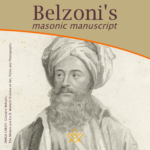 Belzoni's Masonic Manuscript is a valuable resource for anyone interested in the history and practices of Freemasonry, as well as for those interested in the broader cultural and social history of the early 19th century. The manuscript provides a rare glimpse into the inner workings of the organization, and offers insights into its beliefs, values, and practices. It is a fascinating document that continues to captivate and intrigue scholars and freemasons alike. |
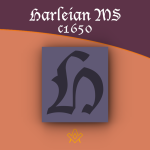 There are two known 'Harleian Manuscripts' which allude to the earliest constitutions of Masonry. |
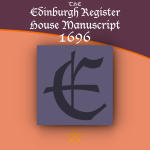 The Edinburgh Register House Manuscript (1696) At the time the manuscript was written in Edinburgh, Scotland was the home to various lodges, including those of the operative Masons of Edinburgh, it provides an interesting Masonic Catechism with questions and answers, a genuine ritual of admission. |
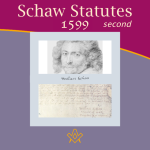 The Second William Schaw Statutes (1599) We look at a modern transcript of the second William Schaw Statutes dated 1599. An operative masons charter for stone cutters and layers in the building industry of the time. A set of rules and regulations including penalties. |
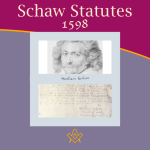 The First William Schaw Statutes (1598) We look at a modern transcript of the first William Schaw Statutes dated 1598. An operative masons charter for stone cutters and layers in the building industry of the time. |
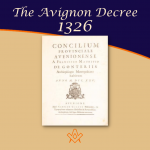 The Avignon Decree (1326) Papal Bull The several Papal declarations against Freemasons after the formation of the Grand lodge in England in 1717 are well known. The Avignon Decree (1326), published 400 years prior, is the earliest known document to set out the Catholic Church's intentions… |
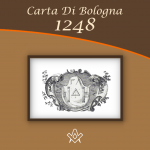 The Bologna Statutes Or Carta Di Bologna The Bologna Statutes or Carta Di Bologna 1248 - Masonic document of Operative Masonry, the oldest one found to date. |
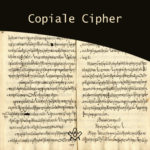 What is the connection between the Copiale Cipher and the great enlightened society of oculists ? |
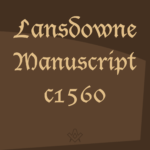 A very foolish legendary account of the origins of the Order of Freemasonry |
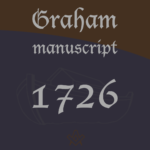 The Graham Manuscript dating from 1726 is an early Masonic document that calls upon Noah and this 3 sons in respect to Masonry, an alternative allegory to the Hiram legend. |
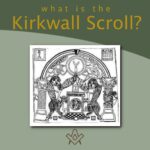 The Kirkwall Scroll is a hand-painted floor cloth depicting a myriad of symbolism |
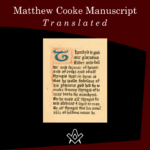 Matthew Cooke Manuscript was written c1450. A transcript of a yet older document, written by a Speculative Mason |
 Are you interested in the 'musty old documents of the past'? This article first appeared in The Builder magazine,1923 |
masonic knowledge
to be a better citizen of the world
share the square with two brothers

click image to open email app on mobile device


